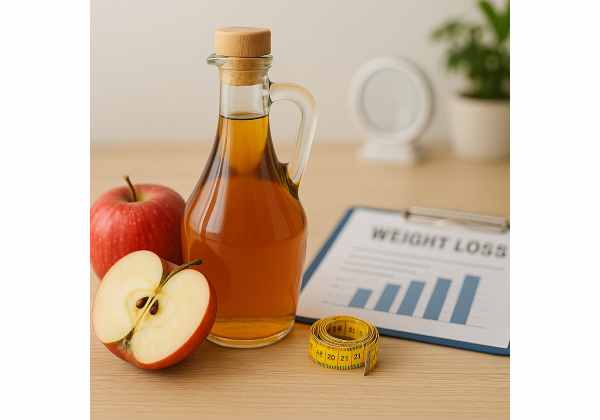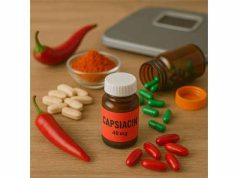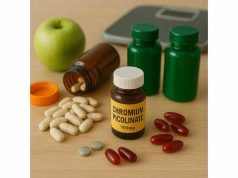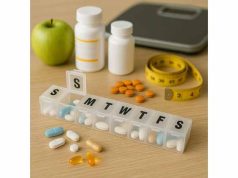
Apple cider vinegar (ACV) shows up in grocery carts, fitness forums, and morning routines with the promise of easier weight control. But what does it actually do, and how should you use it if you decide to try it? This guide translates the research into plain language, explains realistic benefits and limits, and outlines safe, practical ways to incorporate ACV—without hype. You will also see when ACV is not a good idea and what to consider instead, including medically supported routes and lifestyle strategies. If you want a broader view of tools beyond ACV, see our overview of supplement and prescription choices for weight management.
Table of Contents
- Does apple cider vinegar help you lose weight?
- How to use apple cider vinegar for weight loss
- Dose, timing and forms that matter
- Common mistakes to avoid with apple cider vinegar
- Safety, side effects and interactions
- What the research actually shows
- Smart alternatives and when to skip it
- Frequently asked questions
Does apple cider vinegar help you lose weight?
Apple cider vinegar is simply vinegar made from fermented apple juice. Its active component is acetic acid, usually around 5%. In small studies, acetic acid has been shown to slightly reduce post-meal blood glucose spikes, slow stomach emptying, and dampen appetite in some people. Those effects can make a calorie deficit a little easier to maintain, especially if you tend to overeat after high-carbohydrate meals.
What this means in practice: ACV is not a fat-burner. It does not replace calorie control, protein intake, fiber, movement, or sleep. At best, it can be a modest aid that nudges eating behaviors in the right direction—think “supporting actor,” not the lead. When people report success with ACV, it is often because vinegar helps them feel fuller on fewer calories, stabilize energy after meals, or stick to a structured routine.
Expected magnitude: When combined with a calorie-reduced diet, the weight change attributed to vinegar alone is usually small. Short trials have reported losses on the order of 1–3 kg over 8–12 weeks, but results vary and often depend on overall diet quality. Individuals with insulin resistance may notice a more consistent appetite effect than those who are already highly insulin-sensitive.
Where ACV can help most:
- You routinely drink sugary beverages with meals and need a replacement ritual.
- Large carbohydrate portions leave you hungry again soon after eating.
- You respond well to clear pre-meal routines that reduce grazing and snacking.
Where it may do little:
- Your diet is already high in protein and fiber with stable blood sugar control.
- Your main barrier is not hunger, but mindless eating, late-night snacking, or stress.
If you are just starting out and want a bigger foundation before layering in ACV, review our guide to sustainable habits and targets in safe weight loss basics. You will likely get more from vinegar if it complements a plan you can follow.
How to use apple cider vinegar for weight loss
A simple routine works best. The aim is not to “power through” shots, but to build a safe, repeatable habit that blunts appetite and steadies energy.
Start with dilution. Mix 1 teaspoon (5 ml) of ACV into 250 ml (1 cup) of still or sparkling water. Sip it with or 10–15 minutes before your largest meal. If well tolerated after several days, increase to 1 tablespoon (15 ml). Many people settle at 1–2 tablespoons per day total, split across one to two meals.
Pair with protein and fiber. ACV is more effective when the meal already contains 20–40 g of protein and high-fiber carbs (beans, vegetables, whole grains). This combination helps satiety and stabilizes blood sugar. For an added fullness boost at meals that are light on vegetables, consider soluble fiber such as glucomannan or psyllium (see glucomannan or psyllium for details).
Use it to replace, not add. If the vinegar drink replaces a caloric beverage—juice, soda, sweet tea—you can remove 100–200 calories per serving immediately. The habit matters more than the brand.
Build a routine you can keep:
- Choose one meal you tend to overeat.
- Mix ACV into water (never straight).
- Sit down and sip slowly as you plate your food.
- Eat mindfully: lead with protein and vegetables, then starch, then extras.
- Track how hungry you feel two hours later; adjust the next day.
Flavor options: Add a squeeze of lemon, a cinnamon stick, a splash of unsweetened cranberry, or a few ice cubes for a sharper chill. Avoid sweeteners during the first two weeks so you can judge the true effect on appetite.
What not to do: Do not take undiluted shots, do not exceed 2 tablespoons (30 ml) per day without medical input, and do not use ACV as an excuse to skip balanced meals.
Dose, timing and forms that matter
How much acetic acid is in your dose? Most ACV is 5% acetic acid. That equals 0.75 g of acetic acid per tablespoon (15 ml), or 1.5 g for 2 tablespoons (30 ml). Many of the appetite and post-meal glucose effects appear at ~0.75–1.5 g acetic acid per day.
Timing: Taking ACV with food or 10–15 minutes before a carbohydrate-heavy meal tends to produce the most noticeable effect on fullness and post-meal blood sugar. Taking it far in advance of a meal is less useful for appetite, and taking it at bedtime can worsen reflux for some people.
Liquid vs. capsules vs. gummies:
- Liquid ACV (unfiltered, “with the mother”) is predictable: ~5% acetic acid unless the label says otherwise. It is also cheapest. The downside is taste and potential teeth exposure (see dental care below).
- Capsules vary widely. Some list grams of “apple cider vinegar powder” rather than acetic acid content. A capsule may contain far less acetic acid than a tablespoon of liquid. Swallow with water and food to avoid throat irritation.
- Gummies often contain very little acetic acid per serving along with sugars or sweeteners. They are convenient but rarely deliver the amounts used in research.
Dilution and dental care: Keep at least a 1:10 vinegar-to-water dilution. Drink through a straw if you like, and rinse your mouth with water afterward. Wait 30 minutes before brushing so you do not abrade enamel softened by acid.
Stacking with meals:
- Breakfast: If your breakfast is mostly protein (eggs, Greek yogurt), ACV may add little. If it is cereal, toast, or oats, ACV may help curb the mid-morning dip.
- Lunch: Try it before rice or pasta bowls to reduce the urge for seconds.
- Dinner: Useful before bread, potatoes, or takeout where portions are less controlled.
Label literacy: Look for the acetic acid percentage, the serving size, and any additives. If using capsules or gummies, prefer brands that disclose tested acetic acid content and have credible third-party testing (see third-party testing).
Common mistakes to avoid with apple cider vinegar
1) Taking shots undiluted. This is the fastest route to throat irritation, enamel damage, and reflux. Always dilute in water or mix into food.
2) Treating ACV as a free pass. Vinegar does not erase excess calories. If your plate sizes and snacks do not change, your weight will not change.
3) Chasing extreme doses. More is not better. Higher amounts can aggravate reflux, cause stomach discomfort, lower potassium in rare cases, and interact with medications.
4) Relying on gummies as a primary source. Many contain too little acetic acid to matter and can add sugar. They are fine as a convenience, not as a therapeutic dose.
5) Ignoring dental care. Swish with plain water after drinking ACV and delay brushing for at least 30 minutes.
6) Skipping meals in response to nausea. If ACV upsets your stomach, reduce the dose or stop. Forcing it can backfire and lead to overeating later.
7) Using ACV as a “cleanse.” Prolonged liquid cleanses or laxative detoxes can lead to energy crashes, muscle loss, and rebound eating. If you are tempted by “detox” marketing, read our review of the risks associated with detox cleanses.
8) Forgetting the basics. Adequate protein, fiber, step count, resistance training, and sleep drive results. Use ACV to support, not replace, these pillars.
Safety, side effects and interactions
Most healthy adults can tolerate 1–2 tablespoons (15–30 ml) of diluted ACV per day. Still, pay attention to the following cautions.
Gastrointestinal effects: ACV can slow stomach emptying. For people with gastroparesis (delayed gastric emptying, common in long-standing diabetes), this can worsen fullness, bloating, nausea, or reflux. Avoid ACV if you have diagnosed gastroparesis unless cleared by your clinician.
Teeth and throat: Repeated acid exposure can erode enamel and irritate the esophagus. Always dilute, avoid undiluted “shots,” rinse afterward, and wait before brushing.
Potassium and bone health: Very high, prolonged intakes have been linked to low potassium and potential bone effects in case reports. These are uncommon, but they illustrate that chronic overuse is not harmless.
Medication interactions: ACV can enhance glucose-lowering after meals. If you use insulin or sulfonylureas, combining them with vinegar may increase risk of low blood sugar. Monitor closely and ask your clinician before starting. Vinegar may also interact with diuretics and drugs that affect potassium balance.
Who should avoid ACV or seek medical advice:
- People with GERD or frequent reflux (ACV often worsens symptoms).
- Those with gastroparesis or significant GI disorders.
- Individuals with enamel erosion, dental sensitivity, or frequent cavities.
- Anyone on glucose-lowering medications or diuretics.
- Pregnant or breastfeeding individuals should discuss with their clinician first.
If you need a stronger, clinically proven approach—especially for obesity or weight-related complications—talk with your clinician about evidence-based treatments such as GLP-1 medicines (see our plain-language guide to GLP-1 medicines).
What the research actually shows
Study designs: Most vinegar studies are small (dozens of participants) and short (weeks to a few months). Designs vary widely—different doses, timing, and participant characteristics. Many combine vinegar with calorie restriction, making it hard to isolate vinegar’s independent effect.
Mechanisms with plausible support:
- Glycemic impact: Vinegar can reduce the post-meal glucose and insulin response when taken with carbohydrate-rich foods. This may reduce hunger two to three hours later.
- Gastric emptying: Acetic acid slows the rate at which the stomach empties, contributing to fullness.
- Appetite signaling: Some participants report lower appetite or fewer cravings after vinegar with meals.
Weight change: Reported weight loss attributable to vinegar, beyond diet changes, is modest. Typical findings show small additional losses compared with placebo or no vinegar when combined with calorie control. Rebound weight gain after stopping is common if foundational habits are not in place.
Body composition: There is limited evidence that vinegar meaningfully preserves lean mass during weight loss. Prioritize protein and resistance training for that goal.
Metabolic markers: In some trials, vinegar modestly improves fasting glucose, insulin sensitivity, or triglycerides, especially in people with insulin resistance. Effects are inconsistent in healthy, active individuals.
Bottom line: ACV can nudge appetite and post-meal responses in your favor. It is not a substitute for dietary quality, activity, or medical therapy when indicated. If you do not notice an appetite or energy benefit within 2–4 weeks of consistent use, it is reasonable to stop and focus elsewhere (see below). For those considering a medical route, see our overview of weight-loss prescription options.
Smart alternatives and when to skip it
Skip ACV if you experience reflux, nausea, tooth sensitivity, or if you take medications that make hypoglycemia more likely. The benefit is not worth the discomfort or risk.
If the goal is appetite control:
- Emphasize protein at each meal (20–40 g).
- Add soluble fiber (beans, oats, chia, psyllium) to increase fullness.
- Consider low-energy-density foods: broth-based soups, salads, steamed vegetables.
If the goal is better blood sugar after meals:
- Shift a portion of starch to legumes or whole grains.
- Start meals with vegetables and protein, then eat starches.
- Walk 10–15 minutes after larger meals.
If you want a supplement with stronger evidence:
- Caffeine (timed and dosed carefully) can modestly increase energy expenditure and training output, though tolerance develops and side effects matter.
- Green tea extract (EGCG) shows small effects in some people but can irritate the stomach; use cautiously.
- Fiber supplements (glucomannan, psyllium) have some of the best appetite data among over-the-counter options.
If you need clinically meaningful weight loss:
- Consider a prescription plan with your clinician, especially if BMI or health status qualifies you for medical therapy or if you have weight-related conditions. Medications can improve adherence by controlling hunger and cravings when lifestyle change alone has not been enough.
A practical decision rule: If ACV reduces your desire to snack or size up portions without causing reflux or dental issues—and it slots easily into your routine—keep it. If not, redirect your effort to higher-impact levers: protein, fiber, resistance training, step count, sleep, and structured meal planning.
Frequently asked questions
How much apple cider vinegar should I drink a day for weight loss?
Start with 1 teaspoon (5 ml) in 250 ml of water with a meal. If tolerated, increase to 1 tablespoon (15 ml). Many people use 1–2 tablespoons daily total. More is not better and increases risk of reflux, enamel erosion, and low potassium.
Should I take apple cider vinegar before or after meals?
For appetite and post-meal glucose, take ACV with food or 10–15 minutes before carbohydrate-heavy meals. Taking it long before eating is less helpful, and taking it at bedtime can worsen reflux. Always dilute, and do not exceed 2 tablespoons per day.
Does apple cider vinegar burn fat?
No. ACV does not directly burn fat. It may slightly reduce post-meal glucose and slow stomach emptying, which can help some people eat fewer calories. Any weight loss comes from a sustained calorie deficit, not from vinegar itself.
Are ACV gummies as effective as liquid vinegar?
Usually not. Many gummies contain very little acetic acid—far less than a tablespoon of liquid ACV—and sometimes add sugars. If you choose gummies, check tested acetic acid content and treat them as a convenience, not a therapeutic dose.
Can I use ACV if I have diabetes?
Proceed only with your clinician’s guidance. ACV can lower post-meal glucose, which may interact with insulin or sulfonylureas and increase hypoglycemia risk. People with gastroparesis should avoid ACV, as it can worsen symptoms by slowing stomach emptying.
Will apple cider vinegar damage my teeth?
Any acid can erode enamel with repeated exposure. Always dilute ACV, drink it with meals, rinse with water afterward, and wait 30 minutes before brushing. If you have dental sensitivity or enamel erosion, ACV may not be appropriate.
References
- Effects of apple cider vinegar on glycemic control and insulin sensitivity in patients with type 2 diabetes: A GRADE-assessed systematic review and dose–response meta-analysis of controlled clinical trials 2025 (Systematic Review)
- Apple cider vinegar for weight management in Lebanese adolescents and young adults with overweight and obesity: a randomised, double-blind, placebo-controlled study 2024 (RCT)
- The effect of apple cider vinegar on lipid profiles and glycemic parameters: a systematic review and meta-analysis of randomized clinical trials 2021 (Systematic Review)
- Effect of apple cider vinegar on delayed gastric emptying in patients with type 1 diabetes mellitus: a pilot study 2007 (RCT/Pilot)
- Clinical guidelines for dental erosion 2021 (Guideline)
Disclaimer
This article is for educational purposes only and does not replace personalized medical advice. Always talk with your healthcare professional before starting, stopping, or changing any supplement, diet, or medication—especially if you have medical conditions, take prescriptions, are pregnant, or are breastfeeding.
Share and follow
If this guide helped you or someone you care about, consider sharing it. For more practical, evidence-based content on weight management and health, follow us on the social platform you use most—Facebook, X, Instagram, or LinkedIn.










